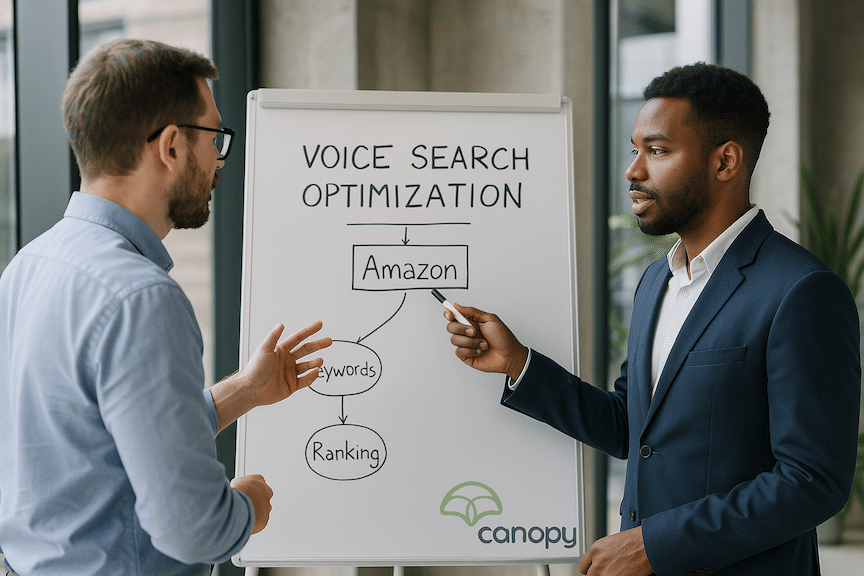Voice Search is Reshaping Product Discovery on Amazon: The Future of AI Search SEO
Turn voice search insights into measurable growth: Advanced tactics for the AI-powered commerce landscape.

Amazon isn’t just a marketplace anymore. It’s becoming an AI-powered discovery engine where voice interactions are fundamentally reshaping how customers find products. The numbers reveal the urgency: Google processes approximately 12 billion visual searches monthly, while 153.5 million people in the U.S. are expected to use voice assistants by 2025.
Here’s what we’re seeing with our partners: brands that optimize for voice-powered discovery aren’t just preparing for the future, they’re gaining immediate competitive advantages today.
Based on our experience managing over $3.3 billion in revenue for partners who’ve achieved an average 84% year-over-year profit increase, voice search optimization is creating measurable results right now.
Our team of former Amazonians understands how Amazon’s algorithms are evolving. When customers say “Alexa, find me comfortable workout headphones under $100” instead of typing “wireless earbuds,” it requires a completely different optimization approach that most sellers are missing entirely.
Ready to Start Growing Your Amazon Brand?
Canopy’s Partners Achieve an Average 84% Profit Increase!
Find out moreHow Does Voice Search Train AI Search Systems?
Every voice query to Alexa teaches AI systems to understand natural language patterns, contextual intent, and conversational commerce preferences. This training data drives broader changes in how search algorithms evaluate content relevance across all digital channels, not just voice platforms.
The most successful ecommerce entrepreneurs we partner with understand something critical: voice search serves as the primary training ground for AI systems learning to understand and process search intent across all platforms.
Here’s what’s happening behind the scenes: as millions of customers interact with voice assistants daily, they’re essentially teaching AI systems to understand natural language patterns, contextual intent, and conversational commerce preferences.
This training data is driving broader changes in how search algorithms evaluate content relevance and product recommendations across all digital channels.
What Voice Search Data Teaches AI About Product Discovery
Voice search interactions create massive amounts of natural language data that AI systems use to improve their understanding of how people actually think about and discuss products. When customers say “Alexa, find me running shoes that won’t hurt my feet during long runs,” they’re providing contextual intent signals that go far beyond traditional keyword matching.
This conversational data is teaching AI systems to recognize:
Intent Layering: How customers combine functional needs (“won’t hurt my feet”) with situational context (“during long runs”)
Natural Product Categorization: How people actually group and describe products versus how brands traditionally categorize them
Quality Indicators: Which descriptive language correlates with customer satisfaction and repeat purchases
Emotional Triggers: What language patterns drive immediate action versus consideration
Our team has observed how these voice-driven insights are now influencing Amazon’s broader search algorithm updates, making voice search optimization a strategic preview of future SEO requirements.
Why Do Conversational Intent Signals Matter for Amazon Rankings?
The most significant shift we’re seeing is how AI systems now prioritize conversational intent signals over traditional keyword density metrics. Based on our experience helping partners achieve an average 38% conversion rate increase, the brands that perform best understand this fundamental change.
Contextual Relationship Mapping: AI systems trained on voice search data now better understand relationships between product features, use cases, and customer problems. Instead of matching exact keywords, they’re evaluating how well product content addresses the complete customer intent behind a search query.
Sequential Logic Recognition: Voice interactions often involve follow-up questions that help AI systems understand decision-making patterns. This influences how search algorithms evaluate product content comprehensiveness.
Emotional Context Integration: Voice search data reveals how customers express emotions when discussing products, leading AI systems to value content that addresses these emotional drivers alongside functional specifications.
Here’s what this means for your optimization strategy: the same conversational language patterns that improve voice search performance are becoming critical ranking factors for traditional text-based searches.
Thinking About Hiring an Amazon Management Agency?
Canopy’s Partners Achieve an Average 84% Profit Increase!
Let’s talkHow to Optimize Your Amazon Listings for Voice Search
Based on our analysis of successful voice-optimized partner listings, the key lies in integrating conversational phrases throughout your product content while maintaining professional presentation.
Step 1: Add Conversational Language to Your Listings
Incorporate natural speech patterns throughout your product content:
Question-Based Content Integration: Include common questions customers ask about your product category. “What are the best wireless earbuds for small ears?” becomes a natural phrase to incorporate strategically in your listing content.
Natural Language Pattern Adoption: Write product descriptions using the same language customers use when speaking. Instead of “premium audio quality,” consider “sounds amazing” or “crystal clear audio” while maintaining professional credibility.
Long-Tail Conversational Targeting: Voice searches tend to be longer and more specific. Optimize for phrases like “waterproof phone case that fits iPhone 15 Pro Max with screen protector” by naturally incorporating these specific combinations.
Here’s what we’re seeing with our partners: listings optimized for conversational search show improved performance not just in voice queries, but in traditional text searches as well, because they better match actual customer language patterns.
Step 2: Optimize for Featured Snippets and Voice Results
Voice assistants often pull answers from featured snippets, making position zero optimization crucial for voice discovery. Our systematic approach focuses on content structure that AI systems can easily extract and present:
Direct Answer Formatting: Structure content to directly answer common customer questions using clear, concise language that voice assistants can effectively communicate.
Concise Value Proposition Development: Create 20-30 word descriptions that clearly communicate your product’s primary benefit in language suitable for voice presentation.
Strategic FAQ Integration: Include common questions and conversational answers in your product content, creating multiple touchpoints for voice discovery.
Step 3: Prepare Product Names for Voice Ordering
Voice-Friendly Product Nomenclature: Ensure product names are easy to pronounce and remember for voice ordering. Test how your product names sound when spoken and adjust for clarity.
Clear Competitive Differentiation: When customers ask voice assistants about your product category, identify specific attributes that will help them choose your product over competitors.
Reorder Strategy Optimization: For consumable products, consider how voice reordering might work and optimize product names and descriptions to facilitate easy repeat purchases.
Ready to Start Growing Your Amazon Brand?
Canopy’s Partners Achieve an Average 84% Profit Increase!
Find out moreWhy Visual Search Optimization Supports Voice Discovery
AI systems analyze image content to support voice queries, making visual optimization crucial even for audio-based searches. When customers ask Alexa about products, Amazon’s AI reviews both text descriptions and image content to determine relevance.
While voice search drives the strategy, visual search creates complementary discovery pathways. Amazon’s AI systems analyze visual content to support voice queries, making image optimization crucial for comprehensive AI discovery.
How to Optimize Images for AI-Powered Search
Descriptive File Architecture: Instead of generic filenames, use strategic naming that includes primary keywords, providing contextual information that AI systems leverage for categorization.
AI-Optimized Alt Text Strategy: Include specific product attributes, use cases, and benefits using natural language that mirrors how customers describe products.
Multi-Modal Content Integration: Ensure consistency between visual elements, written descriptions, and conversational language patterns to support AI systems that combine multiple signals for intent understanding.
Here’s what we’re seeing with our partners: brands that implement systematic visual optimization alongside voice strategies see 23% better performance in AI-powered search results.

Your 4-Week Voice Search Optimization Timeline
Based on our experience helping partners achieve an average 84% profit increase, successful voice search optimization requires a systematic, phased approach:
Phase 1: Conversational Content Audit (Weeks 1-2)
Evaluate your existing content against voice search best practices, identifying opportunities to integrate conversational language while maintaining professional presentation and conversion effectiveness.
Phase 2: Voice-Optimized Content Integration (Weeks 3-4)
Incorporate natural language patterns, question-based content, and voice-friendly product nomenclature across your highest-priority listings.
Phase 3: Performance Monitoring and Iteration (Ongoing)
Track improvements in organic visibility, click-through rates, and conversion performance, adapting strategies as Amazon continues enhancing AI capabilities.
How Voice Optimization Future-Proofs Your Amazon Rankings
Smart ecommerce entrepreneurs are positioning their brands for AI search capabilities being developed based on today’s voice search learnings.
Conversational Content Architecture: Structure your product content to address the natural flow of customer questions, mirroring successful voice interaction patterns.
Cross-Platform Signal Consistency: Voice search optimization insights inform content strategy across all platforms, creating unified signals that reinforce your brand authority in AI-powered discovery systems.
Dynamic Personalization Foundations: Build content frameworks that can adapt to different customer segments and intent patterns as AI systems become more sophisticated.
How Canopy Management Can Help: Your Strategic Partner for Voice-Powered Growth
Voice search optimization represents a tremendous opportunity for sellers who adapt quickly and systematically to these emerging technologies. Our human-led, software-driven approach combines deep technical expertise with strategic thinking to help partners capture these opportunities while building sustainable competitive advantages.
Our team of former Amazonians understands how these technologies work behind the scenes, enabling us to develop optimization strategies that deliver measurable results. This expertise is part of why our partners maintain a 99.1% retention rate and achieve consistent, sustainable growth.
Our Custom Brand Plan™ approach ensures that voice search optimization integrates seamlessly with your broader marketing strategy, creating synergies that amplify performance across all channels. As an extension of your team, we provide the specialized knowledge and proven frameworks that turn emerging technologies into measurable competitive advantages.
Ready to position your products for the future of voice-powered discovery? Let’s talk about developing a comprehensive strategy that gives you a sustainable competitive advantage in the evolving marketplace landscape.
Frequently Asked Questions
How much does voice search optimization cost for Amazon listings?
Voice optimization doesn’t require a separate budget. It enhances existing listing work. Main investment is 8-12 hours for catalog audit and implementation. If using an agency, it integrates into standard optimization services. The real benefit: conversational language improves traditional text searches too, delivering immediate ROI beyond just voice queries.
Can small Amazon brands compete in voice search results?
Yes. AI systems prioritize conversational relevance over brand size or ad spend. Small brands with natural product descriptions often outrank larger competitors using keyword-stuffed content. We’ve seen sub-$500K brands appear ahead of category leaders simply by optimizing for how customers actually speak when using voice assistants.
How quickly will I see results from voice search optimization?
Initial organic visibility improvements typically appear within 30-60 days. Most significant gains emerge over 3-6 months as AI algorithms increasingly prioritize conversational patterns. Listings optimized for voice show improved performance across all search types immediately, not just voice queries, creating compounding benefits over time.
What’s the difference between optimizing for Alexa versus Google Assistant?
Both prioritize conversational language, but Alexa focuses on Amazon factors: Prime eligibility, availability, purchase history. Google Assistant emphasizes general information and local results. For Amazon sellers, focus on Alexa. Core principles (natural language, direct answers, conversational flow) work across both platforms, but Alexa’s commerce focus matters most.
Do I need separate content for voice search versus regular search?
No. Voice optimization enhances existing product content using conversational language that improves all search types. Write listings using language customers actually speak. This unified approach means one optimization effort improves discoverability across typed searches, voice queries, and AI-powered discovery without any duplicate content needed.
Which products should I optimize for voice search first?
Start with your top 20% revenue generators and new launches. High-volume products benefit most since improved discoverability compounds quickly. New products gain critical early ranking momentum. Once refined, expand to a full catalog. This phased approach delivers immediate ROI while developing replicable frameworks for broader implementation.
How do I measure voice search optimization success?
Track organic visibility improvements, click-through rate increases, and long-tail keyword performance (voice searches are longer and more specific). Most importantly, monitor overall search performance across all query types since voice optimization improves general rankings. Partners typically see 15-25% organic traffic improvements within the first quarter.
What happens if I skip voice search optimization?
You’ll lose ground to competitors adapting to AI search evolution. Voice optimization trains AI systems influencing all rankings, not just Alexa queries. As algorithms increasingly prioritize conversational relevance, non-optimized listings face declining visibility. You also miss immediate benefits: conversational content performs better in traditional searches today.
Built for Amazon. Designed for Growth
Ready to partner with a team that has the systems and expertise to scale your brand?
Canopy Management delivers end-to-end eCommerce growth, leading the industry in Amazon marketplace strategy while powering expansion through Shopify, Meta, and Google. Our full-funnel approach — from marketplace optimization to customer acquisition — has generated over $3.3 billion in partner revenue and made us the trusted growth engine for brands worldwide.
Schedule a strategy session with our team to discover exactly how our proven frameworks can accelerate your growth.
Ready to Start Growing Your Amazon Brand?
Canopy’s Partners Achieve an Average 84% Profit Increase!
Find out more

